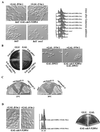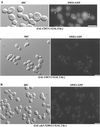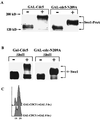Cdc5 interacts with the Wee1 kinase in budding yeast
- PMID: 11438652
- PMCID: PMC87222
- DOI: 10.1128/MCB.21.15.4949-4959.2001
Cdc5 interacts with the Wee1 kinase in budding yeast
Abstract
Development of a multicellular organism requires that mitosis and morphogenesis be coordinated. These processes must also be synchronized during the growth of unicellular organisms. In the yeast Saccharomyces cerevisiae, mitosis is dependent on the prior growth of a daughter cell in the form of a bud. Overexpression of wild-type Polo-like kinase Cdc5 or a catalytically inactive form resulted in the formation of multinucleate cells in budding yeast. Immunofluorescence analysis of these multinulceate cells showed that mitosis and bud formation were no longer linked. Others have shown that Swe1 is required for coupling mitosis to bud formation during a perturbed cell cycle. When the normal pathway of bud formation is perturbed, Swe1 functions to delay mitosis through negative regulation of Clb/Cdk. In cells lacking Swe1, multinucleate cells are formed in response to delays in bud formation. Affinity purification, two-hybrid analysis, and mutant characterization results suggested that Cdc5 and Swe1 interact. From these results, we conclude that multinucleate formation in response to Cdc5 overexpression is linked to titration of Swe1 function. These results also suggest that Cdc5 may be a negative regulator of Swe1.
Figures







References
-
- Aitchison J D, Rout M P, Marelli M, Blobel G, Wozniak R W. Two novel related yeast nucleoporins Nup170p and Nup157p: complementation with the vertebrate homologue Nup155p and functional interactions with the yeast nuclear pore-membrane protein Pom152p. J Cell Biol. 1995;131:1133–1148. - PMC - PubMed
-
- Amon A, Irniger S, Nasmyth K. Closing the cell cycle circle in yeast: G2 cyclin proteolysis initiated at mitosis persists until the activation of G1 cyclins in the next cycle. Cell. 1994;77:1037–1050. - PubMed
-
- Baldin V, Ducommun B. Subcellular localization of human wee1 kinase is regulated during the cell cycle. J Cell Sci. 1995;108:2425–2432. - PubMed
Publication types
MeSH terms
Substances
LinkOut - more resources
Full Text Sources
Other Literature Sources
Molecular Biology Databases
